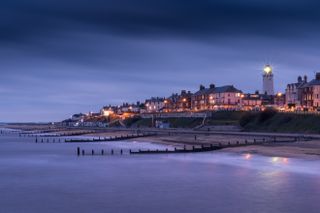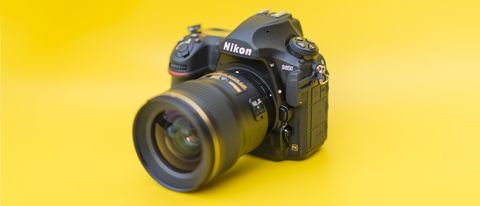Why you can trust TechRadar
Build and handling
- Magnesium alloy body
- Comprehensive weather-sealing
- Weighs 1005g
The Nikon D850 may share similar proportions to the D810, but quite a bit changed from that camera.
Pick it up, and if you're coming from a D810 or D800, the first thing that strikes you is the re-worked grip. It's now that bit deeper, and much more comfortable to hold than its predecessor, especially for longer periods.
As on the D500, Nikon omitted the pop-up flash in an effort to make the camera even sturdier. Some may be sorry to see this feature disappear – we've found it useful in the past for triggering remote Speedlights – but it's always felt like a bit of a weak link on a pro-spec DSLR.
And with no pop-up flash, a tough magnesium alloy body, and weather seals to protect it from the elements, the D850 feels every bit the pro DSLR you'd expect it to be. It's incredibly well made, and there's no question this camera's up for the rigors of professional use.






Compared to the D810, the controls were also tweaked on the D850 – in fact, if you've been shooting with the D500 or D5, it should be pretty much home from home for you, and if you're planning on using different bodies side by side it should making switching between them pretty seamless.
If you're coming from a D810 though, you'll notice that the top plate arrangement has changed for a start, and it's much better for it. The ISO button now sits just behind the shutter button, which makes it easier to adjust single-handed; it's an improvement on the slightly awkward positioning on the D810, where it sat in the cluster of four buttons above the drive mode selector.
The D850 offers a refined shooting experience
Round the back, and along with the tilt-angle display the other notable addition is a small AF joystick, like the one we've seen on both the D500 and D5. This enables you to quickly select your desired focus point, although you can still use the eight-way controller on the back of the camera if you prefer. Its positioning means it falls under the thumb easily; if we're being super-picky it would be nice to be able to assign this as the back-button focus control as well, but the AF-On button is positioned just above the joystick.
As on the D500, you can set the majority of the controls on the Nikon D850 to light up (along with the top-plate LCD) by rotating the on/off switch beyond the 'on' position – it's a really useful feature that makes it much easier to quickly change settings in poor light.
All in all, the D850 offers very refined shooting experience. You'll be able to happily shoot and tweak core shooting settings without taking your eye away from the viewfinder.
Autofocus
- 153-point AF, 99 cross-type AF points
- User-selected array limited to 55 points
- Impressive coverage across the frame
The 51-point autofocus system on the D810 was one of the best performers we'd seen back in 2017, but Nikon equipped the D850 with the same Multi-CAM 20K AF module as its flagship D5.
In our book this is still one of the best, if not the best, autofocus systems we've seen on any DSLR. It features an impressive 153 AF points, of which 55 are user-selectable, while 99 are the more sensitive cross-type points for even greater precision. That's not all – AF sensitivity goes all the way down to -4EV for the central AF point (with the remainder focusing down to -3EV), which should enable the D850 to focus pretty much in almost complete darkness.

Click here to see the full-size image

Click here to see the full-size image

Click here to see the full-size image

Click here to see the full-size image
As we've experienced with the D5, the system is excellent, with sports and action photographers unlikely to be disappointed by the D850's autofocus performance.
If you're coming from the 51-point AF system in the D810 you'll notice the difference, particularly in poor light – even in these tricky conditions the D850's ultra-sensitive AF snapped into focus incredibly quickly.
We tested the D850 in a range of conditions, with its toughest challenge coming when we shot the Tour of Britain's Time Trial stage. With cyclists going flat-out, the D850 didn't let us down; focusing speed was incredibly quick, even letting us grab shots when cyclists appeared in the frame without warning, while it would happily track fast-moving subjects as they moved towards and across the frame.

As with the D5 (and the D500), Nikon has included its clever automated procedure for fine-tuning lenses on the D850. It's an incredibly useful tool for tweaking the performance of prime lenses for critical focusing, and the system on the D850 has been improved to make it even easier to set up and calibrate your lenses.
Something the D850 can't quite match Canon's latest DSLRs for is Live View performance. While the Dual Pixel CMOS technology used in the likes of the Canon EOS 5D Mark IV can rival that of mirrorless cameras, Live View focusing with the D850 is still a little clunky; it's better than previous models, but still not as swift as it could be.
Current page: Build, handling and AF
Prev Page Introduction and key features Next Page Performance and image qualityPhil Hall is an experienced writer and editor having worked on some of the largest photography magazines in the UK, and now edit the photography channel of TechRadar, the UK's biggest tech website and one of the largest in the world. He has also worked on numerous commercial projects, including working with manufacturers like Nikon and Fujifilm on bespoke printed and online camera guides, as well as writing technique blogs and copy for the John Lewis Technology guide.

This Walmart DualSense deal brings the price of my very first colorful PS5 pad down to its lowest since last Black Friday

Nitro Deck discounts have arrived ahead of the Black Friday Nintendo Switch deals - including a huge record-low price on the Retro Purple model

Apple could launch its thinnest-ever iPhone next year
Most Popular


